CADILLAC ESCALADE 2010 3.G Owners Manual
Manufacturer: CADILLAC, Model Year: 2010, Model line: ESCALADE, Model: CADILLAC ESCALADE 2010 3.GPages: 616, PDF Size: 39.41 MB
Page 101 of 616
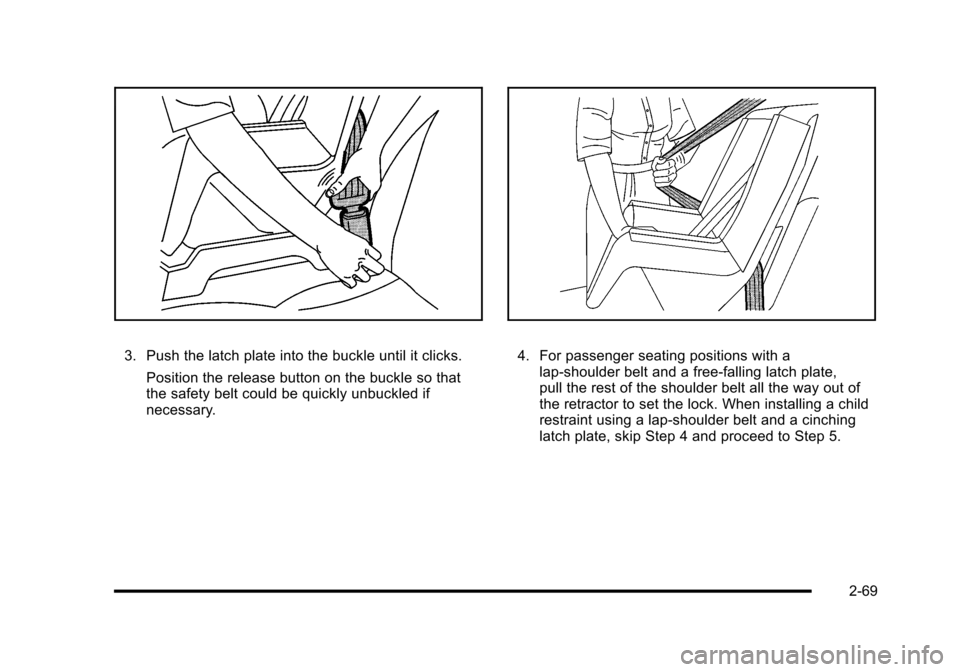
3. Push the latch plate into the buckle until it clicks.
Position the release button on the buckle so thatthe safety belt could be quickly unbuckled ifnecessary.
4. For passenger seating positions with alap!shoulder belt and a free!falling latch plate,pull the rest of the shoulder belt all the way out ofthe retractor to set the lock. When installing a childrestraint using a lap!shoulder belt and a cinchinglatch plate, skip Step 4 and proceed to Step 5.
2-69
Page 102 of 616
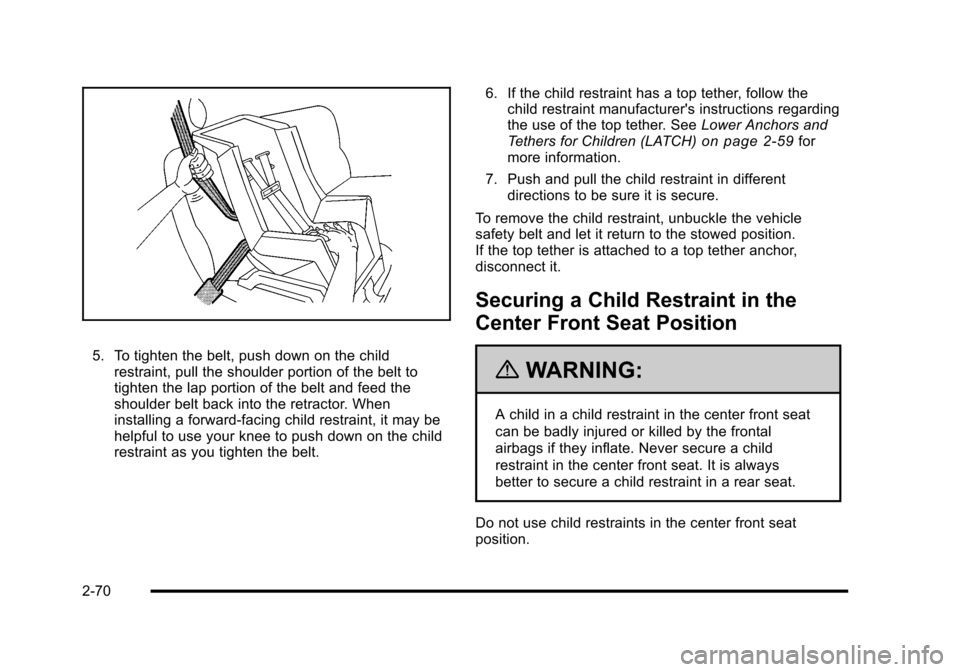
5. To tighten the belt, push down on the childrestraint, pull the shoulder portion of the belt totighten the lap portion of the belt and feed theshoulder belt back into the retractor. Wheninstalling a forward-facing child restraint, it may behelpful to use your knee to push down on the childrestraint as you tighten the belt.
6. If the child restraint has a top tether, follow thechild restraint manufacturer's instructions regardingthe use of the top tether. SeeLower Anchors andTethers for Children (LATCH)on page 2!59formore information.
7. Push and pull the child restraint in differentdirections to be sure it is secure.
To remove the child restraint, unbuckle the vehiclesafety belt and let it return to the stowed position.If the top tether is attached to a top tether anchor,disconnect it.
Securing a Child Restraint in the
Center Front Seat Position
{WARNING:
A child in a child restraint in the center front seat
can be badly injured or killed by the frontal
airbags if they inflate. Never secure a child
restraint in the center front seat. It is always
better to secure a child restraint in a rear seat.
Do not use child restraints in the center front seatposition.
2-70
Page 103 of 616
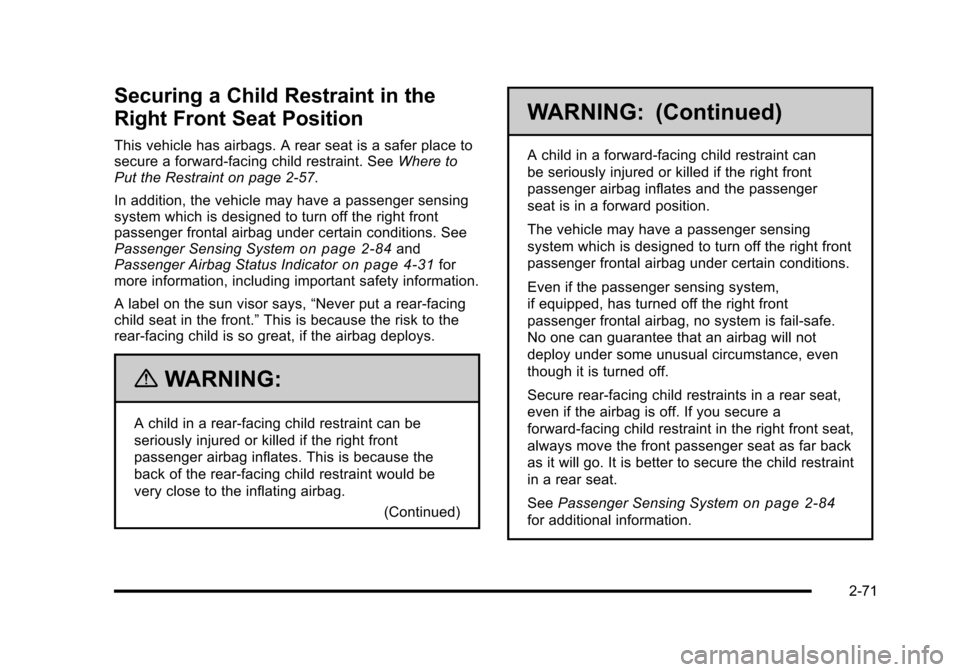
Securing a Child Restraint in the
Right Front Seat Position
This vehicle has airbags. A rear seat is a safer place tosecure a forward-facing child restraint. SeeWhere toPut the Restraint on page 2!57.
In addition, the vehicle may have a passenger sensingsystem which is designed to turn off the right frontpassenger frontal airbag under certain conditions. SeePassenger Sensing Systemon page 2!84andPassenger Airbag Status Indicatoron page 4!31formore information, including important safety information.
A label on the sun visor says,“Never put a rear-facingchild seat in the front.”This is because the risk to therear-facing child is so great, if the airbag deploys.
{WARNING:
A child in a rear-facing child restraint can be
seriously injured or killed if the right front
passenger airbag inflates. This is because the
back of the rear-facing child restraint would be
very close to the inflating airbag.
(Continued)
WARNING: (Continued)
A child in a forward-facing child restraint can
be seriously injured or killed if the right front
passenger airbag inflates and the passenger
seat is in a forward position.
The vehicle may have a passenger sensing
system which is designed to turn off the right front
passenger frontal airbag under certain conditions.
Even if the passenger sensing system,
if equipped, has turned off the right front
passenger frontal airbag, no system is fail-safe.
No one can guarantee that an airbag will not
deploy under some unusual circumstance, even
though it is turned off.
Secure rear-facing child restraints in a rear seat,
even if the airbag is off. If you secure a
forward-facing child restraint in the right front seat,
always move the front passenger seat as far back
as it will go. It is better to secure the child restraint
in a rear seat.
SeePassenger Sensing Systemon page 2!84
for additional information.
2-71
Page 104 of 616
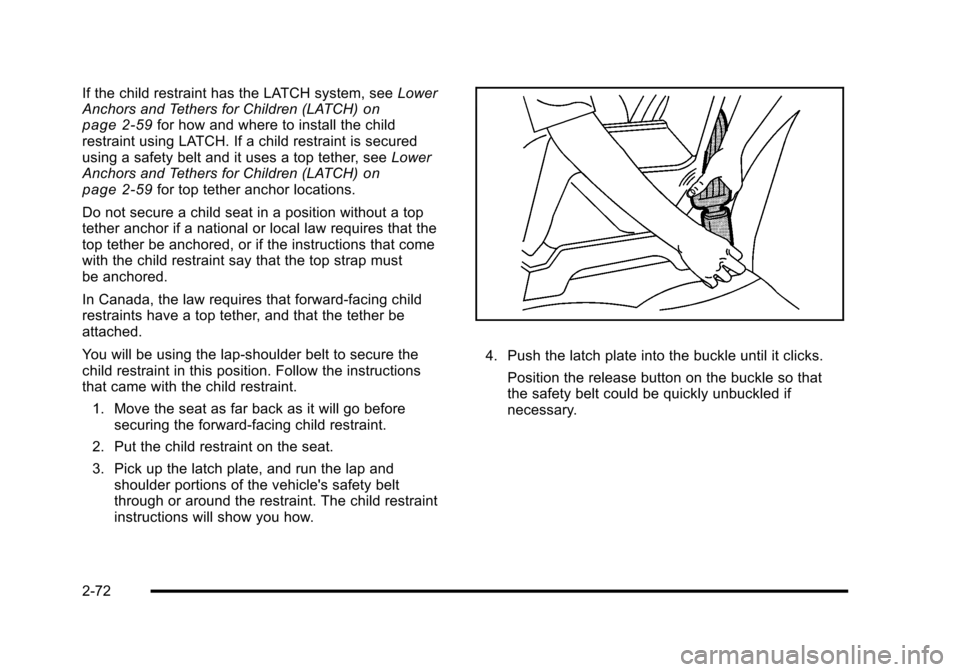
If the child restraint has the LATCH system, seeLowerAnchors and Tethers for Children (LATCH)onpage 2!59for how and where to install the childrestraint using LATCH. If a child restraint is securedusing a safety belt and it uses a top tether, seeLowerAnchors and Tethers for Children (LATCH)onpage 2!59for top tether anchor locations.
Do not secure a child seat in a position without a toptether anchor if a national or local law requires that thetop tether be anchored, or if the instructions that comewith the child restraint say that the top strap mustbe anchored.
In Canada, the law requires that forward-facing childrestraints have a top tether, and that the tether beattached.
You will be using the lap-shoulder belt to secure thechild restraint in this position. Follow the instructionsthat came with the child restraint.
1. Move the seat as far back as it will go beforesecuring the forward-facing child restraint.
2. Put the child restraint on the seat.
3. Pick up the latch plate, and run the lap andshoulder portions of the vehicle's safety beltthrough or around the restraint. The child restraintinstructions will show you how.
4. Push the latch plate into the buckle until it clicks.
Position the release button on the buckle so thatthe safety belt could be quickly unbuckled ifnecessary.
2-72
Page 105 of 616
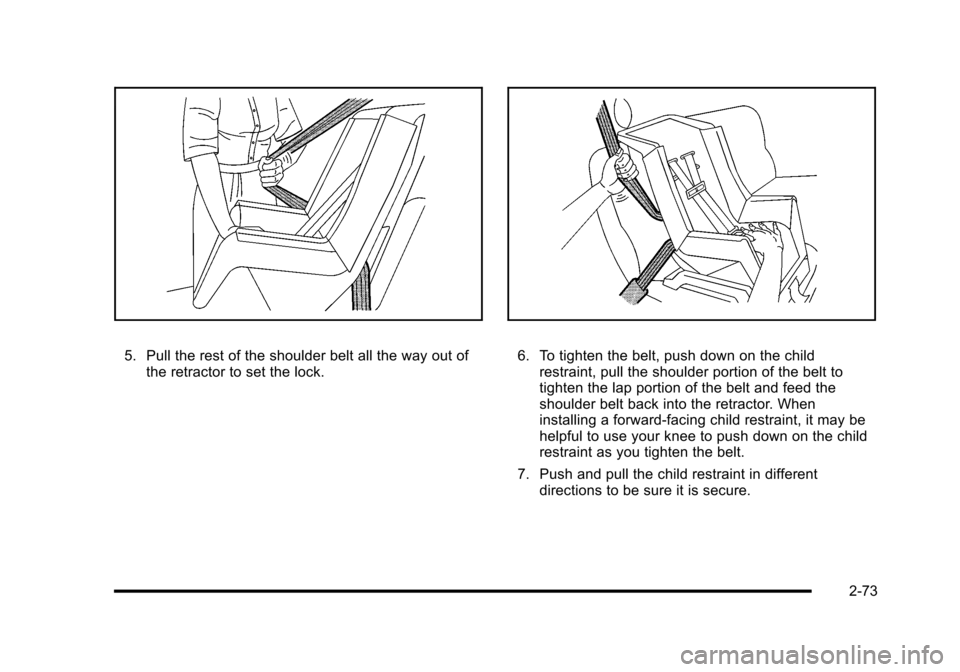
5. Pull the rest of the shoulder belt all the way out ofthe retractor to set the lock.6. To tighten the belt, push down on the childrestraint, pull the shoulder portion of the belt totighten the lap portion of the belt and feed theshoulder belt back into the retractor. Wheninstalling a forward-facing child restraint, it may behelpful to use your knee to push down on the childrestraint as you tighten the belt.
7. Push and pull the child restraint in differentdirections to be sure it is secure.
2-73
Page 106 of 616
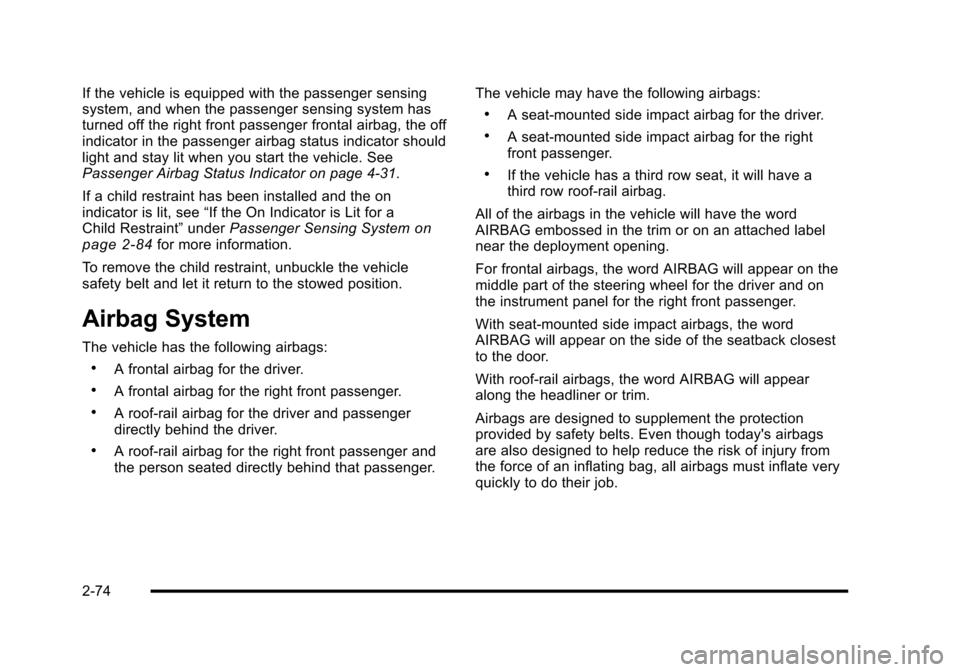
If the vehicle is equipped with the passenger sensingsystem, and when the passenger sensing system hasturned off the right front passenger frontal airbag, the offindicator in the passenger airbag status indicator shouldlight and stay lit when you start the vehicle. SeePassenger Airbag Status Indicator on page 4!31.
If a child restraint has been installed and the onindicator is lit, see“If the On Indicator is Lit for aChild Restraint”underPassenger Sensing Systemonpage 2!84for more information.
To remove the child restraint, unbuckle the vehiclesafety belt and let it return to the stowed position.
Airbag System
The vehicle has the following airbags:
.A frontal airbag for the driver.
.A frontal airbag for the right front passenger.
.A roof-rail airbag for the driver and passengerdirectly behind the driver.
.A roof-rail airbag for the right front passenger andthe person seated directly behind that passenger.
The vehicle may have the following airbags:
.A seat!mounted side impact airbag for the driver.
.A seat!mounted side impact airbag for the rightfront passenger.
.If the vehicle has a third row seat, it will have athird row roof-rail airbag.
All of the airbags in the vehicle will have the wordAIRBAG embossed in the trim or on an attached labelnear the deployment opening.
For frontal airbags, the word AIRBAG will appear on themiddle part of the steering wheel for the driver and onthe instrument panel for the right front passenger.
With seat!mounted side impact airbags, the wordAIRBAG will appear on the side of the seatback closestto the door.
With roof-rail airbags, the word AIRBAG will appearalong the headliner or trim.
Airbags are designed to supplement the protectionprovided by safety belts. Even though today's airbagsare also designed to help reduce the risk of injury fromthe force of an inflating bag, all airbags must inflate veryquickly to do their job.
2-74
Page 107 of 616

Here are the most important things to know about theairbag system:
{WARNING:
You can be severely injured or killed in a crash if
you are not wearing your safety belt—even if you
have airbags. Airbags are designed to work with
safety belts, but do not replace them. Also,
airbags are not designed to deploy in every crash.
In some crashes safety belts are your only
restraint. SeeWhen Should an Airbag Inflate?on
page 2!80.
Wearing your safety belt during a crash helps
reduce your chance of hitting things inside the
vehicle or being ejected from it. Airbags are
“supplemental restraints”to the safety belts.
Everyone in your vehicle should wear a safety belt
properly—whether or not there is an airbag for
that person.
{WARNING:
Airbags inflate with great force, faster than the
blink of an eye. Anyone who is up against, or very
close to, any airbag when it inflates can be
seriously injured or killed. Do not sit unnecessarily
close to the airbag, as you would be if you were
sitting on the edge of your seat or leaning forward.
Safety belts help keep you in position before and
during a crash. Always wear your safety belt,
even with airbags. The driver should sit as far
back as possible while still maintaining control of
the vehicle.
Occupants should not lean on or sleep against the
door or side windows in seating positions with
seat-mounted side impact airbags and/or roof-rail
airbags.
2-75
Page 108 of 616

{WARNING:
Children who are up against, or very close to, any
airbag when it inflates can be seriously injured or
killed. Airbags plus lap-shoulder belts offer
protection for adults and older children, but not for
young children and infants. Neither the vehicle's
safety belt system nor its airbag system is
designed for them. Young children and infants
need the protection that a child restraint system
can provide. Always secure children properly in
your vehicle. To read how, seeOlder Childrenon
page 2!49orInfants and Young Childrenon
page 2!52.
There is an airbagreadiness light on theinstrument panelcluster, which showsthe airbag symbol.
The system checks the airbag electrical system formalfunctions. The light tells you if there is an electricalproblem. SeeAirbag Readiness Lighton page 4!30formore information.
2-76
Page 109 of 616
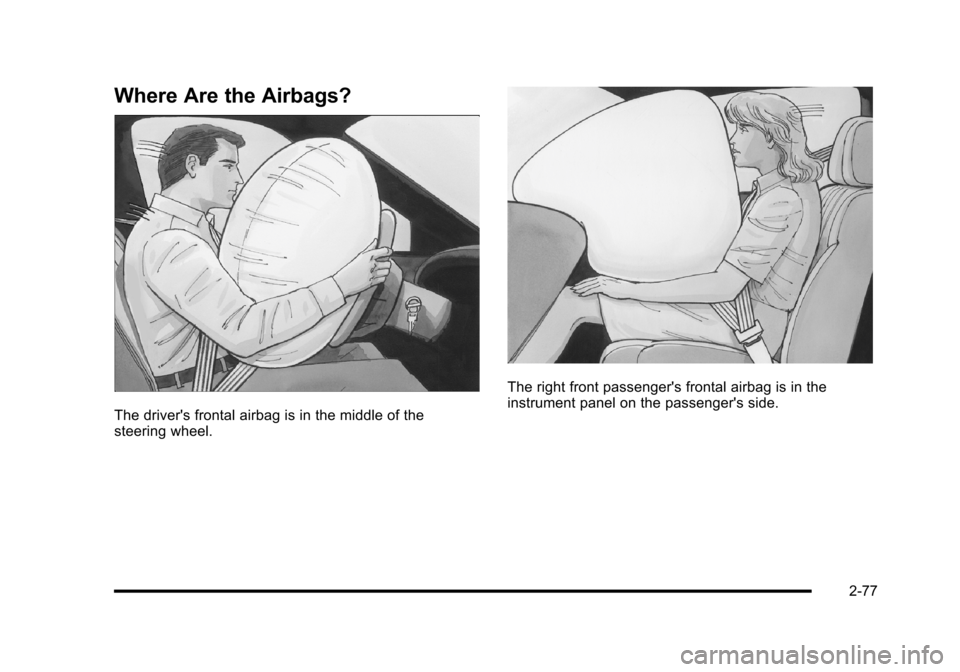
Where Are the Airbags?
The driver's frontal airbag is in the middle of thesteering wheel.
The right front passenger's frontal airbag is in theinstrument panel on the passenger's side.
2-77
Page 110 of 616
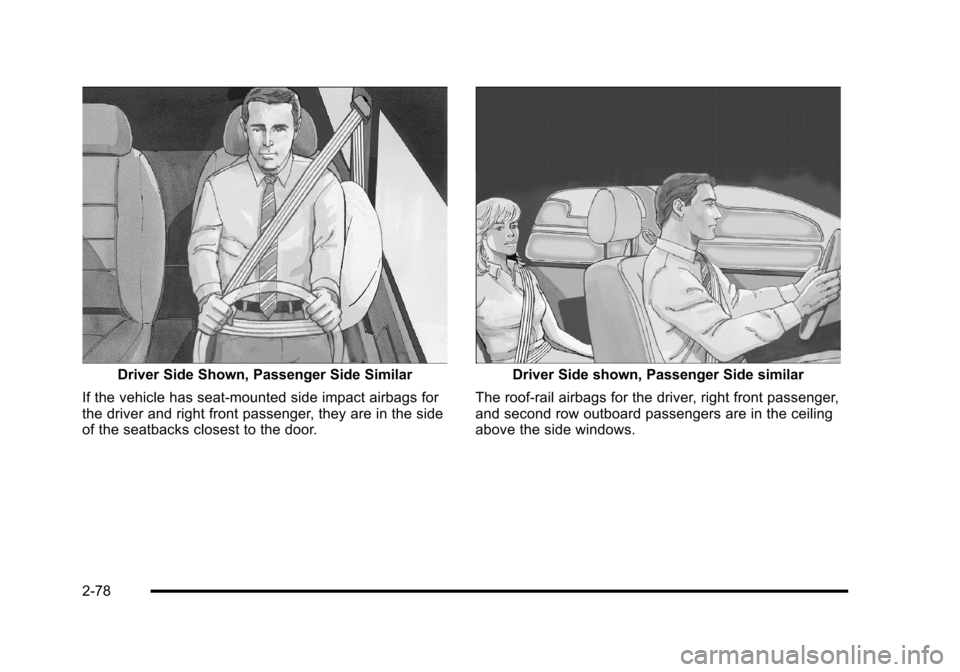
Driver Side Shown, Passenger Side Similar
If the vehicle has seat!mounted side impact airbags forthe driver and right front passenger, they are in the sideof the seatbacks closest to the door.
Driver Side shown, Passenger Side similar
The roof-rail airbags for the driver, right front passenger,and second row outboard passengers are in the ceilingabove the side windows.
2-78